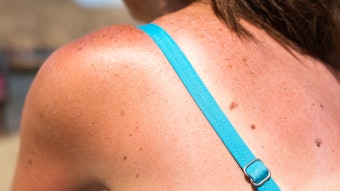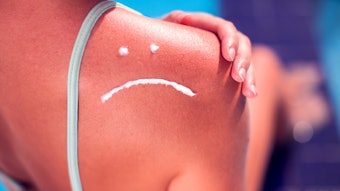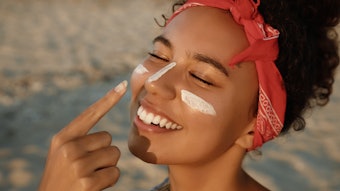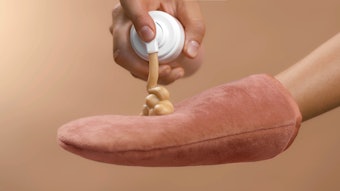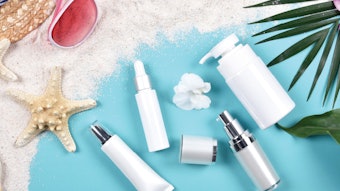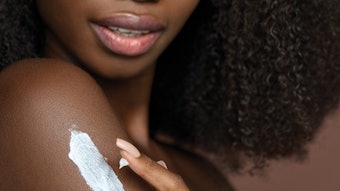
Teaching clients about sun protection, the damage caused to the skin by UV rays and how to choose the right sun care products are some of the most essential tasks faced by the professional skin care industry. Although it may feel light years away, summer will arrive before you know it, and given all of the recent U.S. Food and Drug Administration (FDA) changes to sunscreen legislation, a review of sunscreens is in order.
UVA and UVB
It is well-known that UV exposure involves free radicals and leads to various types of damage at the level of the skin. Indeed, in the skin, free radicals induced by UV radiation cause damage to DNA and proteins, leading to the premature aging of the skin cells. When exposed to UV radiation, the skin undergoes alterations resulting in inflammation, photoaging and various skin disorders. Typical signs of photoaging include wrinkling, loss of elasticity, increased skin fragility and slower wound-healing.1
Specifically, UVB rays are absorbed by epidermal chromophores, such as melanin, and lead to direct molecular damage while also generating free radicals, including the very nefarious hydroxyl radical, which causes DNA damage.2 UVA rays penetrate more deeply in the dermis, increasing the production of free radicals and contributing to long-term cellular damage. Both UVA and UVB rays induce the activation of enzymes that degrade collagen and elastin.3 As such, sun protection is key. Before delving into the various types of sunscreens and molecules involved in these products, three essential concepts should be emphasized.
- A sunscreen product is meant to remain on the surface of the stratum corneum to ensure optimal efficacy against UV radiation.
- Numbers can be misleading. While an SPF 30 blocks about 97% of the sun’s damaging rays, SPF 50 will only block one additional percentage point—98%. As the numbers increase above 30, the additional protection increase is negligible.
- Most consumers do not apply sunscreen at the concentration tested by the U.S. Food and Drug Administration (FDA), meaning that emphasizing how to apply this product to your clients is key. The correct amount of product to use is a teaspoon for the face and a shot glass for the body.4 Repeated application is also key, no matter how high the SPF—think every two hours when indirect sunlight or after swimming.
Sunscreens: An overview
Sunscreen compounds can be classified into three main categories:
- Physical blocks that reflect UV light—for example, by using titanium dioxide molecules of a size of 200–400 µm;
- Physical (mineral) filters that absorb UV light—for example, by using titanium dioxide in nanoparticle size; and
- Chemical filters that absorb UV light—for example, octyl methoxycinnamate.
See Table 1, which outlines these types of sunscreens and their properties.
Physical blocks. Physical blocks are substances with a particle size of about 200–400 µm that act by reflecting solar radiation. The most commonly used blocks are titanium oxide, zinc oxide, iron oxide, mica and silica. The last three mentioned are not sunscreens, but soft-focus effect powders. When incorporated into a cream at such size, titanium and zinc oxides often leave an unsightly white deposit on the skin, which consumers dislike. These compounds, however, are very well tolerated by most skin types, because they do not penetrate the skin, resulting in minimal adverse effects.
Iron oxide, mica and silica are not sunscreen ingredients. From a regulatory perspective, they are considered cosmetic ingredients or excipients that provide skin-coloration or assist in formulation elegance. However, given their particle size, these compounds act as particulate matters that may reflect and scatter UV radiation, although they are not regularly accepted as active sunscreen ingredients.5 Table 2 lists the properties of titanium dioxide and zinc oxide.
Physical filters. The most common example of a physical (mineral) filter is titanium oxide in particle sizes ranging between 15–80 nm. These particles absorb both UVB and UVA radiation. Due to their small size, they do not leave a white deposit on skin upon application, an advantage that is appealing to consumers. However, some have reported that this ingredient leaves a sensation of dryness on the skin.
Chemical filters. Chemical filters are compounds that have one or more aromatic rings fixed on the carbonyl groups associated with a substituent donor of electrons and/or unsaturated carbon chains. Chemical filters are characterized by the wavelength at the absorption maximum, and by their absorption coefficient, which is a unit measure of a chemical filter layer’s ability to absorb the light radiant energy.
Chemical filters have the advantage of being very elegant in cream formulations—the product does not feel heavy, oily or leave a white film. However, chemical filters are known to cause allergic contact dermatitis, irritative dermatitis and photosensitivity.6 The filters that most commonly cause such skin reactions include: benzophenones (benzophenone-3 or oxybenzone), butyl methoxydibenzoylmethane, methoxycinnamate, methylbenzylidene-camphor and aminobenzoic acid. Table 3 on Pages 61 and 62 lists the advantages and limitations of chemical filters.7, 8, 9
Sunscreen buzzwords
Now that you know the different classifications of sunscreens, it is important to understand how they work. Several popular buzzwords used in sunscreen marketing are starting to be regulated by the FDA, including “broad spectrum,” “waterproof,” and “water-resistant.” Nanoparticles and the term “environmental protection factor (EPF)” are also under the microscope.
Broad spectrum. The FDA requires that a sunscreen that carries the label “broad spectrum” provide protection against both UVA and UVB radiation. For a sunscreen to be effective against erythema (redness and sunburn), it must contain filters that absorb UVB radiation. UVA protection is also key because UVA is responsible for photoaging and the skin appearance of actinic keratosis, as well as some forms of skin cancer.
Waterproof or water-resistant. The term “water-resistant” describes a formulation that is not easily washed off by contact with water, usually achieved by the incorporation of silicone oils, dimethicones and/or cyclomethicones. The term “waterproof” is not recognized by the FDA.
Nanoparticles. Titanium dioxide and zinc oxide in nano size (with a particle size of 100 nm or less) are often used as UV filters. When incorporated into sunscreens, these nanoparticles avoid the formation of white and shiny residue typically left on the skin that may be generated when the particles are larger in size. However, in recent years, there has been a public concern in regard to the ability of nanoparticles to penetrate into and through the skin, and potentially cause harmful effects. The European Union requires that, from 2013 onward, the use of nanoparticles in cosmetic products be explicitly declared on product packaging and listed as a part of the ingredients. In the list of ingredients, the substances will be followed by the term “nano” in brackets; for example, titanium dioxide (nano).
EPF. EPF is not a term officially recognized by the FDA; however, some manufacturers use this term to describe the photo-protective effect of some antioxidant molecules, such as green tea. In general, it should be noted that layering antioxidant products under any sunscreen product will enhance overall protection from free radicals, because the antioxidants will neutralize any that are not blocked or absorbed by the sunscreen.
The only constant is change
Overall, what is true in life is true in the realm of sunscreens—the only constant is change. Between innovative ingredients continually developed by cosmetic and pharmaceutical companies, and the ever-shifting guidelines from the FDA, your role as a skin care professional is to continue to educate yourself, and to further educate your clients. In this world of flux, however, two concepts do remain: Sun avoidance is the best anti-aging remedy there is and sun protection is second in line. Because of this, sunscreen should be an essential part of every client’s daily skin care routine.
References
- K Scharffetter-Kochaneck, P Brenneisen, J Wenk, G Herrmann, W Ma, L Kuhr, C Meewes, M Wlaschek, Photoaging of the skin from phenotype to mechanisms, Exp Gerontol 35 307–316 (2000)
- C Nishigori, Y Hattori, S Toyokuni, Role of reactive oxygen species in skin carcinogenesis, Antiox Redox Signal 6(3) 561–570 (2004)
- O Reelfs, RM Tyrrell, C Pourzand, Ultraviolet A radiation-induced immediate iron release is a key modulator of the activation of NF-kappaB in human skin fibroblasts, J Invest Dermatol 122(6) 1440–1447 (2004)
- A Dupuy, A Dunant A, JJ Grob, Randomized controlled trial testing the impact of high-protection sunscreens on sun-exposure behavior, Arch Dermatol 141 950–956 (2005)
- RM Sayre, N Kollias, RL Roberts, A Baqer, I Sadiq, Physical sunscreens, J Soc Cosmet Chem 41 103–109 (1990)
- EJ Collaris, J Frank, Photoallergic contact dermatitis caused by ultraviolet filters in different sunscreens, Int J Dermatol 47(S1) 35–37 (2008)
- JM Allen, CJ Gossett, SK Allen, Photochemical formation of singlet molecular oxygen in illuminated aqueous solutions of several commercially available sunscreen active ingredients, Chem Res Toxico 9 605–609 (1996)
- JF Nash, Human safety and efficacy of UV filters and sunscreen products, Dermatol Clin 24(1) 35–51 (2006)
- C Szurko, A Dompmartin, M Michel, A Moreau, D Leroy, Photocontact allergy to oxybenzone: ten years of experience, Photodermatol Photimmunol Photomed 10 144–147 (1994)
Rachel Ametsitsi recently joined Alchimie Forever as scientific assistant. With research experience and a master of scientific international business, she works in new product R & D, scientific writing and international business development.
Ada Polla is the president, CEO and co-creator of Alchimie Forever. She was a founding member and is the treasurer of the Washington Spa Alliance; was featured on the cover of Business Week Small Biz; and was a nominee for the Emerging Entrepreneur of the Year award from Entrepreneur magazine.
Anne Pouillot joined Alchimie Forever in February 2006 as an intern, then was promoted to scientific and technical assistant, when she obtained her master’s degree in biochemistry with a specialization in plant molecules. She is involved in the conception and formulation of Alchimie Forever products.

